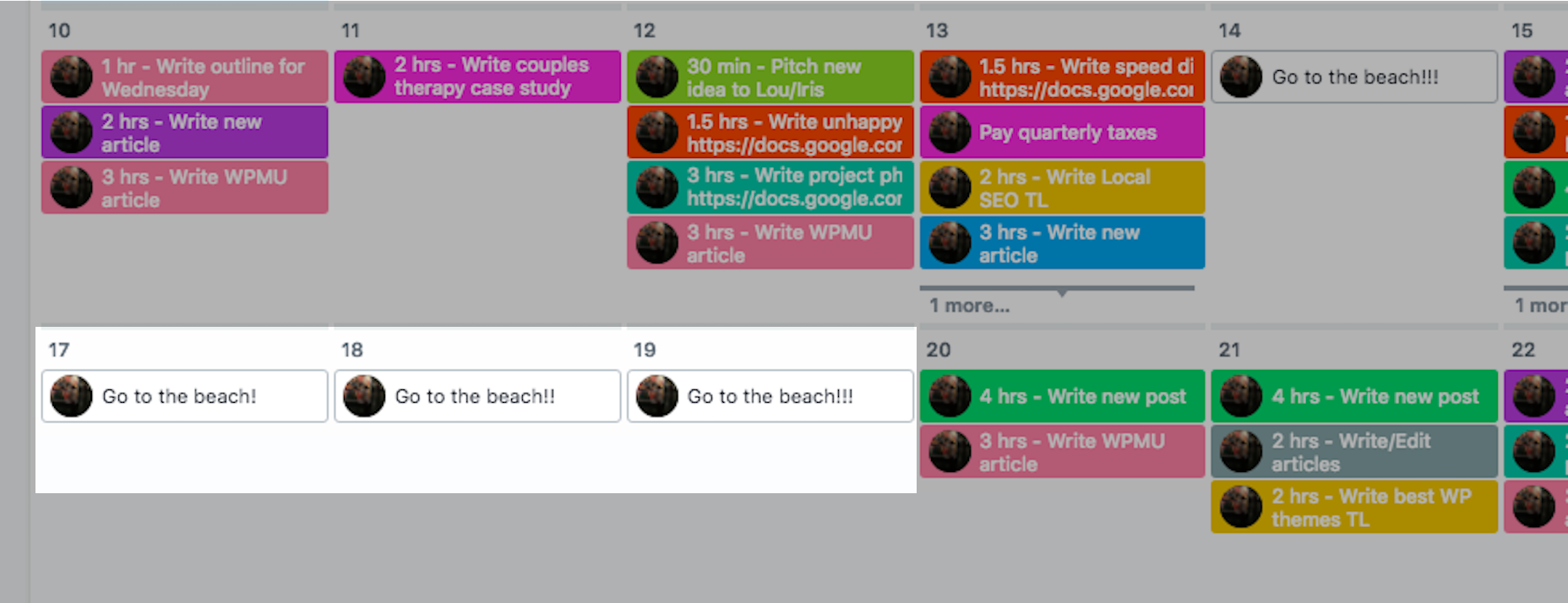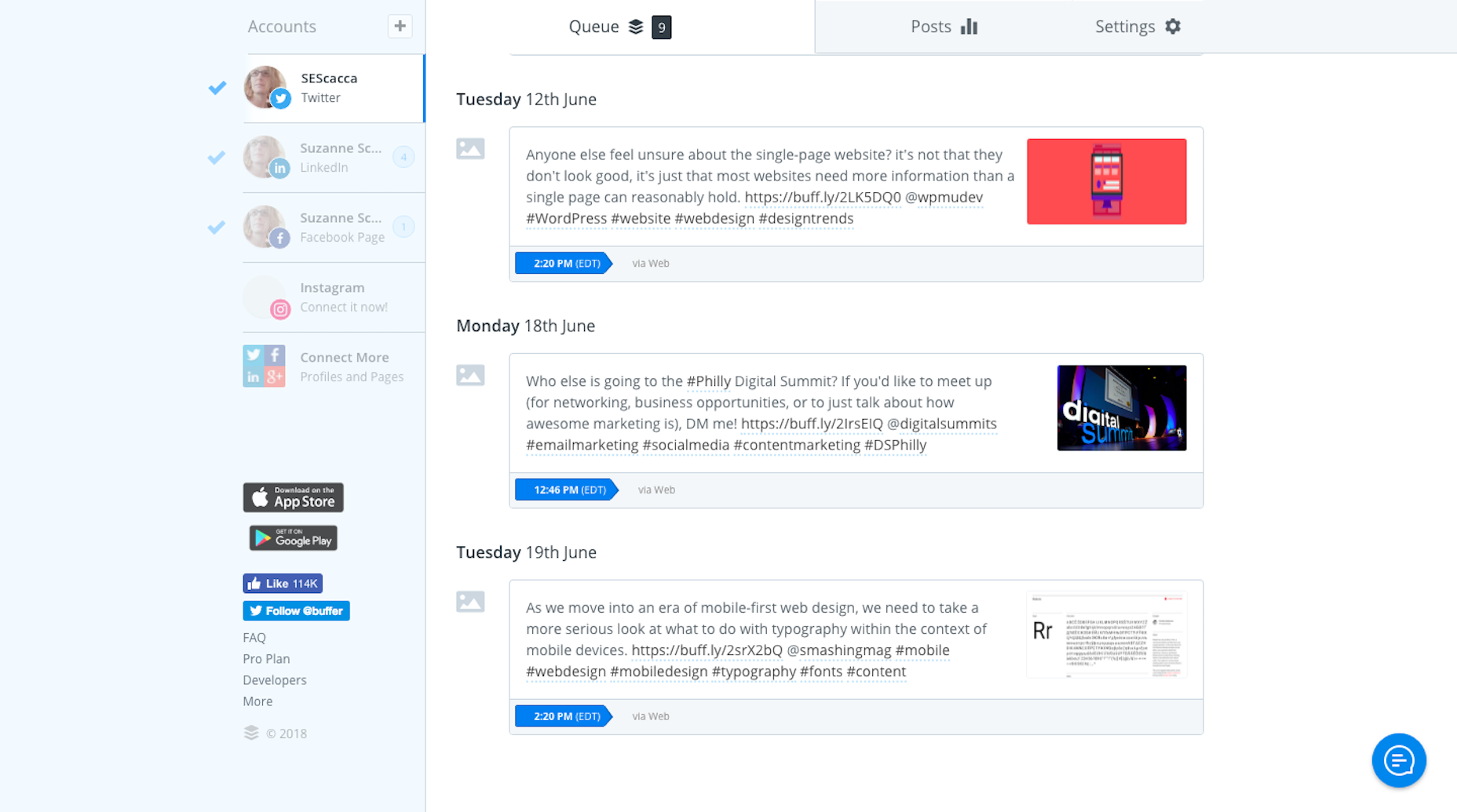Take a Stress-Free Vacation This Summer (and Keep Your Business Running)

12 Tips for Taking a Stress-Free Vacation as a Freelancer
I know it can be so scary to think about taking time away from your business. After all, if you’re not available to work—especially if there’s no one to cover for you—all production stops. Right? Well, not necessarily. Here are some things you can do now to ensure that you have a stress-free vacation and your business isn’t too greatly impacted by your absence.1. Schedule Vacations Ahead of Time
There are times when you’ll feel tempted to take a day off when work is light or non-existent, and you should take advantage of those impromptu opportunities. That said, if you want to take off a larger chunk of time, it’s best to schedule it in advance as it gives you and your clients more time to prepare.2. Schedule Vacations Strategically
Depending on which industry you work for, you may be lucky enough to work with clients that take vacations around the same time every year. Like the education sector being off in the summer. Or certain kinds of sales departments taking a break over the holidays. If there is a low season for you, take advantage of it and schedule your vacation then. You could also plan a vacation around a conference you were planning to attend. For instance, if you’re a WordPress web designer, you might be thinking about attending WordCamp this year. Why not build in a few extra days around it and take a break then? It might also make you feel less guilty about it.3. Take Shorter Vacations
I’m one of those people who feels guilty about taking time off, which is why I plan shorter vacations for myself throughout the year. Rather than do an entire week or two, I schedule three or four days every couple of months. I get the same amount of time off that others do, I just don’t do it all at once.4. Add Time Off to Your Calendar
Once you’ve made the decision to give yourself a break, put it on your calendar so it’s always top-of-mind. If you have a separate system for tracking projects and tasks, add it there too. I write my vacation days into Asana as it keeps me motivated throughout the month to get all my assignments done early. It also helps the planning process so I make sure that all work is accounted for and completed before I leave.
If you have a separate system for tracking projects and tasks, add it there too. I write my vacation days into Asana as it keeps me motivated throughout the month to get all my assignments done early. It also helps the planning process so I make sure that all work is accounted for and completed before I leave.
5. Budget for Vacation Time
If you’re less worried about losing clients or getting behind on work, and more concerned that you’ll lose money by taking a vacation, add vacation-related expenses to your budget. That way, you can adjust revenue and sales goals to compensate for the “loss”. You can always put aside vacation funds every month, the same as you would for rent, insurance, marketing, and other traditional business expenses. If you’d rather not budget for lost time, you could always work weekends to make up for it. For every day you’re away, plan to work one day every weekend until you’ve accounted for the loss. But be careful. This could put you in danger of burnout, which defeats the whole point of going on vacation.6. Notify Current Clients Early
Anything more than two days of unavailability (basically, anything you can’t use a weekend to make up for) should prompt you to notify clients. And you should notify them as soon as you have plans finalized. This way, it won’t be a surprise when a client asks for an ETA on their design project, only for you to tell them it’ll be a couple more weeks because you’re on vacation next week. If you give them enough notice, they’ll be much more understanding.7. Turn on an Autoresponder
For everyone else—inactive clients, prospects, third-party suppliers, or anyone else you’re not in regular contact with—use an email autoresponder to notify them of your absence. It doesn’t need to be anything long nor do you have to tell anyone where you’re going. The only thing I’d suggest is a notice about emergencies. If you want clients to be able to reach you in case something urgent comes up, you can leave an email address or phone number they can use in that case.
It doesn’t need to be anything long nor do you have to tell anyone where you’re going. The only thing I’d suggest is a notice about emergencies. If you want clients to be able to reach you in case something urgent comes up, you can leave an email address or phone number they can use in that case.
8. Keep the Week Before Vacation Light
When scheduling your workload before vacation, don’t plan for anything too critical. In other words, don’t launch a website, don’t send a client their very first set of mockups for review, etc. Don’t put yourself in a situation where an anxious/upset client is left without the ability to talk to you if something goes wrong. Also, don’t take on any new clients or projects before going away. The relationship you have with clients can be delicate at first, so it’s best to kick off new work when you have the time to commit to it fully.9. Automate Whatever You Can
For web designers, automation isn’t necessarily an option. What I would suggest, however, is that if there are any parts of your process you typically outsource to someone else (like a writer, developer, QA), schedule it so your projects sit with them while you’re away. I would also suggest automating as much of your business-specific processes as possible. Marketing is an easy one to do. Write blog posts ahead of time. Create your weekly/monthly newsletter early. Write all corresponding social media messages. Then, use your marketing automation tool to schedule them to go out while you’re away.
I would also suggest automating as much of your business-specific processes as possible. Marketing is an easy one to do. Write blog posts ahead of time. Create your weekly/monthly newsletter early. Write all corresponding social media messages. Then, use your marketing automation tool to schedule them to go out while you’re away.
10. Delegate to Others
If you currently work solo, then this option doesn’t apply; that is, unless you have another web designer you trust to manage your assignments while you’re away. Basically, all they have to do is babysit any clients who have questions or concerns, and address emergencies that come up. There really shouldn’t be much for them to do if you prepped your clients. And you can handle this like a trade: when they go on vacation, you do the same for them. Another option is to hire a virtual assistant to provide coverage, though it’s probably best to get another design expert to hold your place while you’re away.11. Don’t Take Your Computer on Vacation
If you bring your computer on vacation, you’re going to be tempted to work. Instead, rely on your mobile device to provide coverage if it’s needed. Just make sure you set it up beforehand:- Add any apps you might need to handle emergency situations (e.g. Adobe software, WordPress, etc.);
- Filter all work-related emails into a special folder so you’ll know where to check them;
- Add a list of client contacts and project notes to your phone for easy reference.
12. Generate Passive Revenue
The key here is to find a way in which your design business can generate passive revenue: configure your personal website with affiliate marketing, write an ebook, launch a video tutorial series, sell design templates or icons on Dribbble, etc. Then, let this revenue stream provide you with supplemental income that affords you the opportunity to take a stress-free vacation. It may be too late for this one to help you feel better about taking vacation this year, but it’ll definitely lay the groundwork for next year’s if you get started now.Wrapping Up
What is it that you’re afraid of by allowing yourself the time to take a vacation? Afraid you’ll lose money? Afraid clients will abandon you because you spent five business days away from them? Afraid you’ll be too overwhelmed by work when you get home? Whatever it is that scares you, there’s a solution for it.Suzanne Scacca
Suzanne Scacca is a freelance writer by day, specializing in web design, marketing, and technology topics. By night, she writes about, well, pretty much the same thing, only those stories are set under strange and sometimes horrific circumstances.
Read Next
3 Essential Design Trends, November 2024
Touchable texture, distinct grids, and two-column designs are some of the most trending website design elements of…
20 Best New Websites, October 2024
Something we’re seeing more and more of is the ‘customizable’ site. Most often, this means a button to swap between…
Exciting New Tools for Designers, October 2024
We’ve got goodies for designers, developers, SEO-ers, content managers, and those of you who wear multiple hats. And,…
15 Best New Fonts, September 2024
Welcome to our roundup of the best new fonts we’ve found on the web in the previous four weeks. In this month’s edition…
By Simon Sterne
3 Essential Design Trends, October 2024
This article is brought to you by Constantino, a renowned company offering premium and affordable website design
You…
A Beginner’s Guide to Using BlueSky for Business Success
In today’s fast-paced digital world, businesses are always on the lookout for new ways to connect with their audience.…
By Louise North
The Importance of Title Tags: Tips and Tricks to Optimize for SEO
When it comes to on-page SEO, there’s one element that plays a pivotal role in both search engine rankings and user…
By Simon Sterne
20 Best New Websites, September 2024
We have a mixed bag for you with both minimalist and maximalist designs, and single pagers alongside much bigger, but…
Exciting New Tools for Designers, September 2024
This time around we are aiming to simplify life, with some light and fast analytics, an all-in-one productivity…
3 Essential Design Trends, September 2024
September's web design trends have a fun, fall feeling ... and we love it. See what's trending in website design this…
Crafting Personalized Experiences with AI
Picture this: You open Netflix, and it’s like the platform just knows what you’re in the mood for. Or maybe you’re…
By Simon Sterne
15 Best New Fonts, August 2024
Welcome to August’s roundup of the best fonts we’ve found over the last few weeks. 2024’s trend for flowing curves and…
By Ben Moss















